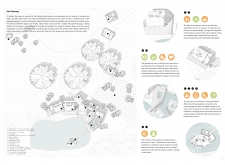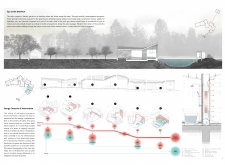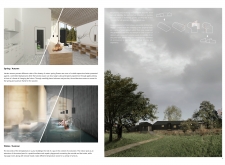5 key facts about this project
### Overview
The project "Interfacing Nature and the Body" is located in a forested area of Latvia, adjacent to a tranquil pond. It focuses on creating a connection between visitors and the surrounding rural landscape through the principles of ecotourism. The design fosters an environment that encourages serenity and visitor engagement with diverse natural elements. This concept emphasizes sustainable practices while responding dynamically to the area’s flora and fauna.
### Site and Spatial Organization
#### Strategic Planning
The building's layout consists of a series of interconnected, smaller volumes that respond to the site's natural contours and micro-climates. Each structure is designed to provide unique spatial experiences, enhancing user interactions while facilitating engagement with the local environment. Porches are incorporated to create a transition between indoor and outdoor areas, effectively merging built spaces with the ecosystem.
### Material Selection and User Experience
#### Resource Utilization
The project prioritizes sustainability through careful material choices that resonate with local contexts. Primary materials include:
- **Wood**: Incorporated for its warmth, creating continuity with the landscape.
- **Glass**: Used in expansive windows to enhance visual connections between interiors and the outdoors.
- **Clay**: Utilized in spa services and workshops, emphasizing the therapeutic qualities of local resources.
- **Concrete**: Selected for its structural properties and thermal efficiency, contributing to the building's energy performance.
The design also integrates local materials into visitor activities, such as pottery and soap making, which enrich the overall experience and encourage interaction with the landscape throughout various seasons, allowing for diverse activities that align with natural cycles.
### Energy Efficiency and Cultural Context
The project emphasizes energy efficiency by harnessing residual heat from spa operations to maintain comfortable indoor conditions, minimizing thermal loss. This approach to sustainability is matched by an architectural language that reflects traditional Latvian forms, focusing on simplicity and functionality. By drawing from vernacular styles, the design maintains cultural integrity while addressing contemporary ecotourism needs.





















































